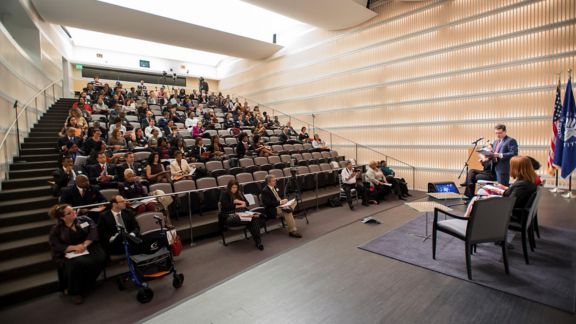The Forgotten Middle in 2033

Overview
A new NORC at the University of Chicago analysis updating the groundbreaking “Forgotten Middle” study finds that there will be 16 million middle-income seniors in 2033. Many will struggle to pay for the health, personal care, and housing services they need. For instance, excluding home equity, nearly three-quarters of middle-income seniors in 2033 will have insufficient financial resources to pay for assisted living if they need and want it. Even with home equity, nearly 40 percent will not be able to afford assisted living.
NORC published the original “Forgotten Middle” study in 2019. It was the fifth most-read Health Affairs article that year. That first-of-its-kind study examined how the number, demographics, health status, and financial resources of middle-income seniors would change in the coming decade. It demonstrated that many middle-income seniors will likely have health and mobility needs and will not be able to pay for services currently available in the market without additional financial help from family members.
With support from The SCAN Foundation, NORC used data from the 2018 Health and Retirement Study (HRS) to reassess the income thresholds, health needs, and care solutions most pertinent to the current policy debate. The updated research revealed several key findings:
- In addition to nearly doubling in size, the middle-income senior cohort will be more diverse in 2033, with people of color comprising 22 percent of the group.
- Many middle-income seniors will have health needs, like mobility limitations (56 percent) and cognitive impairments (31 percent), that make it hard to live independently.
- Nearly three-quarters of middle-income seniors will have insufficient resources to pay for private assisted living without selling their homes.
Methodology
This analysis relies on the Health and Retirement Study (HRS), using 2018 as a base year. NORC examined individuals 60 and older in 2018 since they will be 75 or older in 2033. For each individual in the sample, the researchers modeled the probability of living to 2033 for inclusion in the future seniors cohort.
The researchers then examined the time-invariate demographic attributes of this group, such as gender, race, and education. They estimated people’s health, cognitive function, and mobility status, assuming the same rates of these conditions in the 2018 population for each demographic subgroup.
The researchers also modeled these individuals’ future financial resources, starting from their actual income and assets in 2018. They grew these assets based on the historical rate of change for each type of financial resource and annuitized assets across an individual’s life expectancy.
The researchers analyzed financial resources at an individual level instead of a household level, as is common. By characterizing resources at an individual level, the research is better able to account for differences in life expectancy and health needs of spouses. This also enables us to compare resources against annual housing and care costs.
The analysis’ measure of financial resources includes income streams (i.e., Social Security) and annuitized assets (i.e., retirement savings or mutual funds). For some seniors, adult children may make financial contributions to support their senior housing and care, though this analysis does not assume any financial support from adult children. The researchers include information about housing equity but hold this separately as some individuals may be reluctant to sell their home or may have a spouse who continues to live in the home. Additionally, some seniors may want to retain their home as a “nest egg” to protect against outliving their assets or having a catastrophic health event.
Related Tags
Project Leads
-
Sai Loganathan
Principal Health Economist







